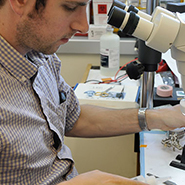This project explores children's understanding of the geometrical concepts necessary to reason about how the shape of a triangle will change when changes are made to the distance between, or the measure of, the bottom two angles. Past research has shown that children struggle to master these concepts throughout the elementary school years. This project explores the nature of this difficulty and possible underlying causes for the difficulty by examining children's spoken and gestured explanations of their own answers, as well as the impact of providing explanations on their overall patterns of responding. The goal of this project is to characterize children's understanding of the triangle completion task and to develop an intervention that will test possible mechanisms by which it can be overcome.
Development of Intelligence
 Understanding the development of intelligence in a human infant is a key project of CBMM. This project engages the fundamental tradeoff between nature and nurture, or priors and data, and ultimately the origin of priors—how constraints are selected by evolution, encoded in genes, and instantiated in genetically wired brain circuits.
Understanding the development of intelligence in a human infant is a key project of CBMM. This project engages the fundamental tradeoff between nature and nurture, or priors and data, and ultimately the origin of priors—how constraints are selected by evolution, encoded in genes, and instantiated in genetically wired brain circuits.
This project also represents a novel developmental approach to building human-like artificial intelligence systems and comprehensive computational models of human cognitive architecture. Instead of branching out from a single area of adult human intelligence, we start with an integrated cognitive model of multiple core capacities in the young child’s mind, along with a set of developmental or learning mechanisms for scaling up to an adult model.

